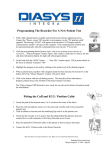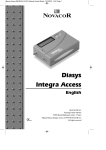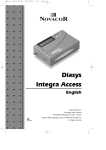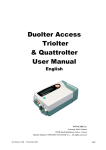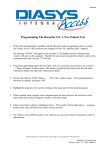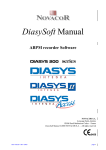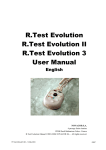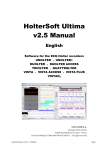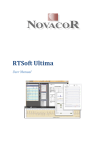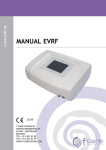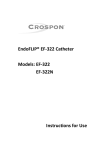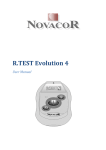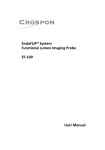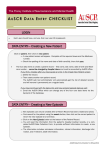Download How the Diasys Integra II functions
Transcript
Manuel Dia II GB 05.qxd 01/02/2005 14:48 Page 1 Diasys Integra II Manual English NOVACOR SA. 4, passage Saint-Antoine 92508 Rueil-Malmaison Cedex - France Diasys Integra II Manual ©2005 NOVACOR SA. - All rights reserved. Manuel Dia II GB 05.qxd 01/02/2005 14:48 Page 2 1. Introduction 4 2. Guarantee 5 2.1. Specific guarantees concerning units 5 2.2. Specific guarantees concerning accessories 5 2.3. Restrictions of the guarantee 5 2.4. Responsibilities 5 2.5. Upgrades 6 2.6. Copyrights 6 3. How the Diasys Integra II functions 7 3.1. Auscultatory mode 8 3.2. Oscillometric mode 8 3.3. Automatic mode 3.4. BP Measurement accuracy 8 9 4. Description of the equipment Diasys and standard accessories Main optional accessories 10 10 10 4.1. The Diasys Integra II recorder 11 4.2. The battery charger 12 4.3. The cuff and the air/electric double tubing for connection to the Diasys Integra II 13 5. Preparing Diasys Integra II for monitoring 5.1. Preparing the battery 5.1.1. The battery charger 14 15 15 5.1.2. The battery 17 5.1.3. Charging the battery 17 5.1.4. End of charge 5.2. Inserting the battery into the recorder 18 19 5.2.1. Insertion 19 5.2.2 Safeguard battery (non-rechargeable lithium) 20 5.3. Programming the Diasys Integra II 20 5.3.1. Programming the time 21 5.3.2. Programming the date 22 5.3.3. Programming intervals 23 5.4. Placing the cuff on the patient 24 5.4.1. The standard cuff 24 5.4.2. Recommandations for positionning the cuff 26 2 • Diasys Integra II Manual - GB - Revision 4 Manuel Dia II GB 05.qxd 01/02/2005 14:48 Page 3 Summary 5.4.3. Changing arm 28 5.4.4. Setting up the ECG system 28 5.4.4.1. Index of arterial distensibility (QKd) 5.4.5. Position sensor 30 31 5.4.5.1. The ECG cable integrated position sensor 31 5.4.5.2. The orthostatism cable integrated position sensor 31 6. How the unit functions 6.1. Start up 34 34 6.2. Test measurements 35 6.3. Manually activated measurements 37 6.4. Palliative measurements 37 6.5. “Suspend” mode 37 6.6. Measurements which are not memorised 38 6.7. Display of measurements 38 6.8. Stopping measurements 39 6.9. Display codes 39 7. Reading the recordings 41 7.1. Transmission to a PC or a printer 41 7.2. Modem transmission 42 8. Precautions of use 44 8.1. Handling the equipment 44 8.2. Cleaning the equipment 44 8.3. Maintenance 45 8.4. Calibration test 45 8.5. Replacing the safeguard battery 46 8.6. Storage and dispatching 47 8.7. Preventative maintenance 47 8.8. Electrical safety standards 47 8.9. Others precautions of use 48 8.10. Physical specifications 49 8.11. Technical specifications 50 Diasys Integra II Manual - GB - Revision 4 • 3 Manuel Dia II GB 05.qxd 01/02/2005 14:48 Page 4 1. Introduction The Diasys Integra II is a non-invasive ambulatory system for measuring and recording blood pressure. As well as measuring the systolic, diastolic, mean blood pressure and heart rate, it can also, in its most advanced version, indicate patient position and calculate the index of arterial distensibility (QKd). The Diasys Integra II unit weighs about 195g and contains the electronic system and pneumatic inflation module. It is linked to the patient’s cuff with a tubing system. The measurements made by the Diasys Integra II can be printed out directly in report form by a dedicated printer connected to the unit. If a computer is used, recording conditions and criteria can be fixed, and the results of the procedure can be selected, organised, stored and printed out in a fully customised report. 4 • Diasys Integra II Manual - GB - Revision 4 Manuel Dia II GB 05.qxd 01/02/2005 14:48 Page 5 2. Guarantee 2. Guarantee NOVACOR undertakes to deliver merchandise in compliance with the technical specifications mentioned and to replace any merchandise recognised as being defective. 2.1. Specific guarantees concerning units Each unit possesses its own specific serial number which identifies it. NOVACOR guarantees the unit for a period of one year from the date of delivery against any defect resulting in an abnormal function of the unit. 2.2. Specific guarantees concerning accessories Equipment which is not an integral part of the unit, in particular the accessories and cables, are not covered by the guarantee. Cables with serial numbers are guaranteed for three months. 2.3. Restrictions of the guarantee The guarantee does not apply to: 1. units repaired or opened up outside our workshop. 2. units damaged by negligence, by accident, or because the instructions in the user manual have not been correctly followed. If necessary, contact your distributor or our maintenance service. We do not accept units which have been returned without prior agreement. 2.4. Responsibilities NOVACOR will not, under any circumstances, be held responsible for physical or material damage of whatever nature, arising either directly or indirectly from improper use of the unit or from failure to follow the instructions in the user manual. Although NOVACOR manufactures products to the highest standards, it cannot guarantee or be held responsible for the validity or accuracy of the measurements made by its units. Therefore, connection of the unit, interpretation of the ensuing clinical results and the diagnosis established from them, are the entire responsibility of the physician. Diasys Integra II Manual - GB - Revision 4 • 5 Manuel Dia II GB 05.qxd 2.5. 01/02/2005 14:48 Page 6 Upgrades All customers duly registered with NOVACOR, or where applicable, with one of its distributors, will be kept informed, to the best of NOVACOR’s ability, of any upgrades to the Diasys Integra II as they become available. 2.6. Copyrights Diasys Integra II manual ©2005 NOVACOR S.A. All rights reserved. Diasys Integra II, DiasySoft, HolterSoft and their respective logos, are registered trademarks of NOVACOR S.A. Macintosh is a registered trademark of Apple Computer International. Windows is a registered trademark of Microsoft Corporation. 6 • Diasys Integra II Manual - GB - Revision 4 Manuel Dia II GB 05.qxd 01/02/2005 14:48 Page 7 How the Diasys Integra II functions The Diasys Integra II is a non-invasive automatic ambulatory blood pressure recorder. It has two standard modes of operating, the Auscultatory mode and the Oscillometric mode. The required mode is selected with the DiasySoft or HolterSoft software. If neither of these modes has been specifically programmed, the Diasys Integra II will choose the most appropriate mode for the patient, according to its own criteria: this is the Automatic mode. Manuel Dia II GB 05.qxd 01/02/2005 14:48 Page 8 3.1. Auscultatory mode The auscultatory method is based on detection of the appearance and disappearance of Korotkoff sounds using a microphone which is usually placed over the humeral artery of the patient’s left arm. When the Diasys Integra II is in the auscultatory mode it can benefit from ECG gating which, by opening a “gate” after detection of the QRS complex, increases the accuracy of measurements made in an artefacted environment (very active patient, for example). The R wave of the cardiac systole (QRS) is detected in board in a single channel ECG cable. ECG gating enables the QKd interval, a true index of arterial distensibility, to be calculated. The QKd is defined as the interval between the onset of the R wave and detection of the associated Korotkoff sound corresponding to the last Korotkoff sounds before diastolic pressure. 3.2. Oscillometric mode The oscillometric mode is based on analysis of the shape of the oscillometric curve of the cuff pressure, of which the maximum point represents the mean pressure. In this mode the patient must stay still during the measurement. 3.3. Automatic mode This is the standard operating mode if no other mode has been specifically programmed. In this mode the two test measurements made at the beginning of monitoring are carried out as follows: • the first measurement tests the quality of the K2 component of the Korotkoff sounds so that monitoring can be adapted accordingly, • the second measurement tests this component having adjusted the numerical filter. If, after this double test, the K2 component is sufficiently consistent, the Diasys Integra II will choose to function in the auscultatory mode. If not, the unit will opt for the oscillometric mode. 8 • Diasys Integra II Manual - GB - Revision 4 Manuel Dia II GB 05.qxd 01/02/2005 14:48 Page 9 3. Functions 3.4. BP Measurement accuracy Blood pressure measurements determined with this device are equivalent to those obtained by a trained observer using the cuff/stethoscope auscultatory method, within the limits prescribed by the American National Standard, Manual, Electronic or automated sphygmomanometers. Diasys Integra II Manual - GB - Revision 4 • 9 Manuel Dia II GB 05.qxd 01/02/2005 14:48 Page 10 Description of the equipment Diasys and standard accessories • Diasys Integra II recorder, • 2 rechargeable (NiMH) batteries, • cuff with double air/electric tubing for connection to the Diasys, • protective pouch and belt. Main optional accessories • battery charger, • ECG cable with position sensor, • single use cuff protectors, • DiasySoft or HolterSoft software, customised according to the programming options required, and the user’s language, and access key, • printer, • Diasys-Printer or Diasys-Computer link cable, • Diasys-Modem link cable. Manuel Dia II GB 05.qxd 01/02/2005 14:48 Page 11 4. Description of the equipment 4.1. The Diasys Integra II recorder M P Mode selector M= measurement / P= program P mode: display switched on (On) and validation of options (Valid) M mode: monitoring started and activation of a manual recording (Rec) Electric connector Air connector Rec On/Valid Stop Select ECG cable and position sensor connection RS232 connector for printer, ordinateur or modem P mode: next choice (Select) M mode: stop measurements (Stop) Battery cover Diasys Integra II Manual - GB - Revision 4 • 11 Manuel Dia II GB 05.qxd 01/02/2005 14:48 Page 12 4.2. The battery charger Red light: power (low brightness) charging (normal brightness) discharge (blinking) Green light: end of charge (batteries ready to use) Battery slot The Diasys functions exclusively with a high capacity rechargeable battery (NiMH), making it economical and environmentally friendly. Batteries are recharged with a fast battery charger specially designed for the Diasys to ensure optimum performance and long-life. The charger is connected to the mains outlet via a transformer and has 2 lights on its front panel. 12 • Diasys Integra II Manual - GB - Revision 4 English 12 V direct current Manuel Dia II GB 05.qxd 01/02/2005 14:48 Page 13 4. Description of the equipment 4.3. The cuff and the air/electric double tubing for connection to the Diasys Integra II The Diasys Integra II cuff offers features which have been specially designed for ambulatory recording: • cone-shaped for better ergonomics, • stabilising flap for optimal positioning, • washable material. It is made up of: • a bladder, • a fabric cuff cover, • a double air/electric tubing for connection to the Diasys. These items can be changed separately if necessary. Diasys Integra II Manual - GB - Revision 4 • 13 Manuel Dia II GB 05.qxd 01/02/2005 14:48 Page 14 Preparing Diasys Integra II for monitoring To prepare the unit, follow the instructions below. • Charge the battery • Insert the battery into the unit • Program the unit • Place the unit and cuff on the patient • Start up the unit and carry out the test measurements If any problem occurs, please contact your local representative for assistance. Manuel Dia II GB 05.qxd 01/02/2005 14:48 Page 15 5. Preparing for monitoring 5.1. Preparing the battery 5.1.1. The battery charger The Diasys charger is fast, fully automatic and easy to use. Red light low brightness: power on normal brightness blinking: discharging normal brightness fixed: charging Green light: end of charge The front panel There is an indicator light (LED) on each side of the slot into which the battery is placed. The RED light indicates: • that the charger is working correctly when it is plugged into the mains outlet: fixed light - low brightness. • that the battery is being discharged, when discharge prior to charge has been programmed (see chapter 5.1.3.): blinking light - normal brightness. • that the battery is being charged: fixed light - normal brightness. The GREEN light indicates that the operation is finished and the battery is charged. Diasys Integra II Manual - GB - Revision 4 • 15 Manuel Dia II GB 05.qxd 01/02/2005 14:48 Page 16 The back panel (base) A selector (2 red switches) determines the charge mode. It is advisable not to change the position of these switches. ON 1 2 ON 1 2 It is, however, possible to implement an immediate charge by changing the position of Switch 1. SWITCH 1 /ON Discharges the battery before recharging it (factory setting) SWITCH 1 /OFF Immediate charge • Whichever mode is chosen, the green light comes on when the battery is charged indicating that it is ready to be used. • The position of switch 2 should never be changed and should always remain in the position shown above. • Never use the charger with any batteries other than those supplied by NOVACOR. • External power sources must comply with electrical safety EN 60-601 standards. 16 • Diasys Integra II Manual - GB - Revision 4 Manuel Dia II GB 05.qxd 01/02/2005 14:48 Page 17 5. Preparing for monitoring 5.1.2. The battery The Diasys Integra II is delivered with two rechargeable Nickel-Metal Hydride (NiMH) batteries (ref. D10-1000). These batteries have been specially developed for the Diasys series and can be recharged about 500 times if used according to the recommendations in this manual. Precautions to be taken with the batteries: • Take care not to invert the polarities. • Do not store over 45°C. • Do not exceed the recommended recharge time, otherwise the unit risks stopping during a recording. • Do not store charged or discharged batteries in the unit. 5.1.3. Charging the battery R ef .D N 10 -1 E H IE L A R B E A m T E 50 T A G 5 B AR V H C ,6 E 3 R HiM 00 0 • Plug the charger into a compatible mains outlet (check carefully that the voltage marked on the charger transformer corresponds to the voltage of your mains supply). The red light will come on immediately with low brightness. • Place the battery in the charger taking care to match the + and - signs on the battery with the same signs on the charger. • Insert the battery into its slot. Diasys Integra II Manual - GB - Revision 4 • 17 Manuel Dia II GB 05.qxd 01/02/2005 14:48 Page 18 • When the battery is placed in the charger the red light will become brighter and will either be: - fixed (immediate charge mode), - or blinking (discharge before recharge mode). • Duration of charge cycle: - without prior discharge: about 1 hour maximum, - with prior discharge: discharge (up to 1h30) + charge (about 1h). • Do not use any charger other than the one supplied by Novacor to recharge Diasys batteries. • Go through the charge cycle: - systematically when new batteries are used for the first time, - at least once a year if the batteries are not in regular use, - If the battery has been stored out of the charger for more than two weeks since last being charged. 5.1.4. End of charge When the green light is on, the battery is ready to be used and can be removed for storage or left in the charger until required. Caution: if a charged battery is removed from the charger and not used for more than two weeks, we recommend that it be recharged again in case it has discharged itself. • Do not leave a battery in the charger if it is not plugged into the mains, it will quickly lose its charge! • Do not leave the charger plugged into the mains unnecessarily. • Do not leave a charged battery in a charger plugged into the mains for a long period of time. • Do not start a recording using a battery only part-charged, the unit may stop during the recording. 18 • Diasys Integra II Manual - GB - Revision 4 Manuel Dia II GB 05.qxd 01/02/2005 14:48 Page 19 5. Preparing for monitoring 5.2. Inserting the batteries into the recorder 5.2.1. Insertion Slide the battery cover off and, if there is already a battery in the unit, remove it. Insert a recharged battery into the unit taking care not to invert the polarities. • Slide the cover towards the outside. • The arrow on the battery should be pointing towards the bottom of the compartment, as shown below. If it is difficult to insert the battery into its compartment, do not try to force it in. Check that the above instructions have been carefully followed before trying again. • Holding the battery in place in its compartment, slot the battery cover back into its grooves and slide it back into place. • The battery must be replaced before each new clinical procedure. 000 101 f. D Re R BA NiMECH TTE H - ARGRIE 3,6 EA V - BL 55 E 0m AH • Do not store the Diasys with a discharged battery in it. Do not leave a recharged battery in the Diasys for more than a month without using it. Diasys Integra II Manual - GB - Revision 4 • 19 Manuel Dia II GB 05.qxd 01/02/2005 14:48 Page 20 5.2.2. Safeguard battery (non-rechargeable lithium) The Diasys Integra II is equipped with a safeguard battery enabling programming settings and data in memory to be protected if the main battery fails or is missing, thus providing the user with maximum security. The safeguard battery has a lifetime of 3 to 5 years. It is not accessible from the exterior of the unit. Its status is systematically tested every time an NiMH battery is placed in the unit, as follows: when the battery is inserted, the Diasys automatically tests the safeguard battery and displays one of the following messages for 3 seconds: either indicating that the lithium battery is functioning correctly, or indicating that the lithium battery is not functioning (see chapter 8 “Replacing the safeguard battery”). 5.3. Programming the Diasys Integra II M P (Mode selector in Programming position) Only manual programming operations are described here. Software programming operations are fully explained in the corresponding DiasySoft or HolterSoft manual. We recommend that a recharged battery be inserted before each new programming operation. If the battery is run down, the Diasys will display the message “Er 14”. If it is dead, the unit’s keys will be blocked (safeguard mode). During programming, if the selector or the two programming keys are not used for a certain time, the screen will switch itself off to save battery power. Press one of these two keys to retrieve the time screen. 20 • Diasys Integra II Manual - GB - Revision 4 Manuel Dia II GB 05.qxd 01/02/2005 14:48 Page 21 5. Preparing for monitoring 5.3.1. Programming the time Press Valid to display the time. Press Select and the first digit will flash. Press Select to obtain the correct digit. Press Valid to confirm. The second digit will flash. Adjust the second digit and press Valid to confirm. The AM/PM setting will flash. Press Valid to make AM flash. If PM is required, press Select, then Valid. Adjust the two minute digits as above. When the last digit has been validated, all four digits will flash. Press Valid to confirm the time. The date will be displayed. Stop Rec Select On/ Valid Stop Rec Select On/ Valid Stop Rec Select On/ Valid Stop Rec Select On/ Valid Stop Rec Select On/ Valid Stop Rec Select On/ Valid Stop Rec Select On/ Valid Stop Rec Select On/ Valid Note that the AM/PM setting is only proposed if the time is programmed before midday. Diasys Integra II Manual - GB - Revision 4 • 21 Manuel Dia II GB 05.qxd 01/02/2005 14:48 Page 22 5.3.2. Programming the date Press Select to choose the date format (dd-mm or mm-dd). Press Valid to confirm. The first digit will flash. Press Select to obtain the correct digit. Press Valid to confirm. The second digit will flash. Adjust the other digits as above. Press Valid to confirm. When the last digit has been confirmed, all four digits will flash. Press Valid to confirm the date. The year will be displayed. Press Select until the year is correct and press Valid to confirm. Press Valid again to confirm and move onto programming the intervals or press Select to adjust the other digits, then confirm by pressing Valid. Stop Rec Select On/ Valid Stop Rec Select On/ Valid Stop Rec Select On/ Valid Stop Rec Select On/ Valid Stop Rec Select On/ Valid Stop Rec Select On/ Valid Stop Rec Select On/ Valid Stop Rec Select On/ Valid Invalid date If a year is incompatible with the month and date previously selected, the year and the date will be displayed alternately, rapidly blinking. • Press Valid to reprogram the date and the year. • Or press Select to reprogram just the year. 22 • Diasys Integra II Manual - GB - Revision 4 Manuel Dia II GB 05.qxd 01/02/2005 14:48 Page 23 5. Preparing for monitoring 5.3.3. Programming intervals The daytime (sun) and night-time (moon) images are displayed alternately next to the corresponding intervals. Press Select and the daytime interval will flash. Press Select to adjust the daytime interval. Press Valid to confirm the daytime interval. The night-time interval will flash. Press Select to adjust the night-time interval. Press Valid and the new intervals will flash alternately. Press Valid to end the programming. The time screen will be displayed. Stop Rec Select On/ Valid Stop Rec Select On/ Valid Stop Rec Select On/ Valid Stop Rec Select On/ Valid Stop Rec Select On/ Valid Stop Rec Select On/ Valid The following intervals are available: Intervals in minutes daytime 2 - 3 - 4 - 5 - 6 - 10 - 15 - 20 - 30 - 45 - 60 night-time 10 - 15 - 20 - 30 - 45 - 60 When the selector is in the programming mode, press the pink key (On/Valid) if you wish to scan the unit’s program: Time, Date, Year, Measurement intervals. Diasys Integra II Manual - GB - Revision 4 • 23 Manuel Dia II GB 05.qxd 5.4 01/02/2005 14:48 Page 24 Placing the cuff on the patient Fig. 1 - Patient equipped with Diasys and cuff 5.4.1. The standard cuff • Locate the path of the humeral artery (ideally with a stethoscope) about 2 cm above the crease of the elbow. • Clean the inside of the arm and apply an anti-perspirant if necessary. • We recommend you place a single-use cuff protector on the inside of the cuff for hygiene reasons: - take the protections off the adhesive strips, - apply the adhesive strips on the inside of the cuff, lining the cuff connector up to the edge of the pouch (Fig 2). Fig 2 Positioning the cuff protector 24 • Diasys Integra II Manual - GB - Revision 4 Manuel Dia II GB 05.qxd 01/02/2005 14:48 Page 25 5. Preparing for monitoring • Position the markings on the cuff (arrow and “ART”) opposite the artery and wind the cuff evenly around the arm (Fig 3). Fig 3 - Positioning the cuff • Pass the tubing behind the patient’s neck and connect first the microphone, then the air tubing to the Diasys (Fig. 4), with the diasys already in its pouch. 4A Stop Stop Select Select I N T E G R A 4B I N T E G R A Fig 4 - Connecting the cuff to the Diasys Diasys shown without its pouch for better illustration Diasys Integra II Manual - GB - Revision 4 • 25 Manuel Dia II GB 05.qxd 01/02/2005 14:48 Page 26 • When the test measurements have confirmed that the microphone is working correctly, click an adhesive patch (ref. D10-8073) onto the stabilising flap behind the air tubing and place it on the patient’s arm to ensure that the cuff stays in place during the whole of the monitoring (Fig 5). 4A 4B Fig 5 - Clicking an adhesive pad onto the stabilising flap and placing it on the patient’s arm This precaution is strongly recommended if the auscultatory mode has been chosen. 5.4.2. Recommendations for positioning the cuff - Cuff size It is essential to choose the appropriate size of cuff for the circumference of the patient’s arm, to avoid any discomfort or measurement errors. The maximum arm circumference for the cuff is given by lining up the two vertical lines where “MAX” is printed. Above this limit, a larger cuff should be used. The minimum arm circumference for the cuff is given by lining up the two vertical lines where “MIN” is printed on the cover. 26 • Diasys Integra II Manual - GB - Revision 4 Manuel Dia II GB 05.qxd 01/02/2005 14:48 Page 27 5. Preparing for monitoring X MA MIN X MA X MA Correct Maximum Cuff too small Fig 6 - Position of the cuff Arm circumference Cuff 18 - 24 cm Small 24 - 32 cm Standard 32 - 40 cm Large Table: recommended cuff size for arm circumference - Cuff shape The Diasys cuff is conical, and thus perfectly adapted to the anatomy of the arm. However, to avoid any risk of discomfort for the patient, positioning still requires particular attention: The two areas of velcro must be lined up and opposing. The cuff must be wound evenly. The cuff should be neither too loose (this could increase the inflation time and result in a malfunction, in which case the relevant error code would be displayed) nor too tightly wound around the patient’s arm (uncomfortable). Diasys Integra II Manual - GB - Revision 4 • 27 Manuel Dia II GB 05.qxd 01/02/2005 14:48 Page 28 5.4.3. Changing arm The cuff has been designed so that it can, if necessary, be worn on the right arm. This is done as follows: - Disconnect the air tubing from the Diasys. - Open the cuff cover and the velcro, remove the bladder and the tube. - Turn the bladder over. - Put the bladder back in the cuff making sure it is flat, with the tube coming out opposite the stabilising flap. - Close the cuff. 2 11 4 31 . Changing the bladder over The active side of the microphone (without the sticker) must always be against the arm. 5.4.4. Setting up the ECG system The ECG gating system, which can only be used in the auscultatory mode, requires the use of an optional single channel ECG cable (namely the “ECG Cable with position sensor”), which is placed on the patient’s chest in the CM5 position using 3 solid gel electrodes: - Click the three gel electrodes onto the snap fasteners on the cable. 28 • Diasys Integra II Manual - GB - Revision 4 Manuel Dia II GB 05.qxd 01/02/2005 14:48 Page 29 5. Preparing for monitoring - Place the electrodes as in figure 3. Fig 3 Placing the ECG cable CM Position sensor N V5 Rec On/Valid Stop Select Diasys Integra II - Insert the connector fully (the red arrow face up). D - Then click on the fixing head. D Diasys Integra II Manual - GB - Revision 4 • 29 Manuel Dia II GB 05.qxd 01/02/2005 14:48 Page 30 To disconnect the cable: - Remove the fixing head by pushing on the sides. D D - Then take out the cable by pressing on the top of the connector. D This system gates the Korotkoff sounds which occur after each QRS complex, thus filtering artefacts more efficiently and significantly reducing measurement time. As ECG gating is based on detection of QRS complexes, it is not suitable for patients with pacemakers functioning in the AAI, DDD or associated modes. Only VVI, VVIR, or VDD pacemaker patients would benefit from ECG gating. 5.4.4.1. Index of arterial distensibility (QKd) Using the ECG cable also enables the QKd interval, a true index of arterial distensibility, to be measured. The QKd interval is the time between the onset of the QRS complex and detection of the last Korotkoff sound at the level of the humeral artery during indirect measurement of the blood pressure. This interval is dependant mainly on the pulse wave velocity. Measuring the QKd interval rather than pulse wave velocity has the advantage of being automatic, rapid, simple and reproducible. 30 • Diasys Integra II Manual - GB - Revision 4 Manuel Dia II GB 05.qxd 01/02/2005 14:48 Page 31 5. Preparing for monitoring The QKd interval is significantly reduced in hypertensive patients compared to normotensive patients of the same age and is therefore a simple method for estimating their arterial distensibility. Measurement of the QKd interval and its clinical analysis can only be carried out if the QKd option of the DiasySoft or HolterSoft software has been installed. 5.4.5. Position sensor An optional feature of the Diasys is a system enabling the unit to detect the patient’s position at any given time [vertical (awake) or horizontal (resting)], in particular during measurements. The patient’s position is indicated next to each measurement both on the Diasys display screen and on the printed report. ( : vertical position : horizontal position) 5.4.5.1. The ECG cable integrated position sensor This sensor is positioned at the thorax and differentiates between a “lying” position and all other positions. It can also be used to automatically change the measurement interval from daytime to night-time, and vice versa, and trigger measurements should the position change. 5.4.5.2. The orthostatism cable integrated position sensor This sensor is positioned on the thigh and differentiates between a “standing” position and all other positions. It can also automatically trigger measurements should the position change. To benefit from the features associated with the position sensors other than position identification, the POSITION option of the DiasySoft or HolterSoft software must be installed. Diasys Integra II Manual - GB - Revision 4 • 31 Manuel Dia II GB 05.qxd 01/02/2005 14:48 Page 32 DIASYS INTEGRA 08 07 95 Dr. (1-31)(1-12) Patient / Paziente / Paciente : Blondin : 07:20 Age / Alter / Età / Edad / Idade : 65 : 22h35 Sexe / Sex / Geschlecht / Sesso / Sexo : M 64/80 (80%) Mesures / Measurements / Messungen / Misurazioni / Medidas ? 18:34 18:40 18:45 19:00 19:15 19:30 19:45 20:00 20:15 20:30 20:45 21:00 21:15 A.nc OSC A.nc OSC A.nc OSC A.nc OSC A.nc OSC A.nc OSC A.nc K+ K+ K+ K+ O K+ K K+ K+ K+ K+ K+ K+ SYS DIA 102 89 90 104 108 109 112 128 96 81 92 96 89 70 72 72 72 70 69 94 100 60 62 62 64 64 X 81 78 78 83 83 82 100 109 72 68 72 75 72 32 17 18 32 38 36 18 28 36 19 30 32 25 80 81 75 72 71 75 75 83 80 81 75 78 83 Conclusions / Conclusions / Schlußfolgerungen / Conclusioni / Conclusiones / Conclusões Example of a report using the position sensor. 32 • Diasys Integra II Manual - GB - Revision 4 blind zone QKd blind zone QKd gate Detection of a Korotkoff sound at diastolic level Detection of a QRS complex 14:48 gate Detection of a Korotkoff sound at diastolic level Detection of a QRS complex 01/02/2005 ECG channel Auscultatory channel Manuel Dia II GB 05.qxd Page 33 5. Preparing for monitoring Diasys Integra II Manual - GB - Revision 4 • 33 Manuel Dia II GB 05.qxd 01/02/2005 14:48 Page 34 How the unit functions 6.1. Start up M P (Mode selector in Measurement position) Before putting the Diasys in its pouch, check that the mode selector is in the MEASUREMENT position and that the unit is not connected to a terminal (which would be indicated by “COMM” on the display). To start up the unit, keep the pink key pressed down and release it after the 4th beep. One of the following messages will be displayed for 10 seconds: Battery replaced since previous start up. Battery not replaced since previous start up (battery should be changed). Manuel Dia II GB 05.qxd 01/02/2005 14:48 Page 35 6. How the unit functions Press the pink key briefly during this 10 second display and monitoring begins in: • the AUSCULTATORY mode if the Diasys Integra II was programmed for this by the DiasySoft or HolterSoft software. AUSC will be displayed before each measurement; • the OSCILLOMETRIC mode if the Diasys Integra II was programmed for this by the DiasySoft or HolterSoft software. OSCI will be displayed before each measurement; • the AUTOMATIC mode if neither of the above modes was specifically programmed. AUTO will be displayed before the two test measurements and thereafter either AUSC or OSCI will be displayed before each measurement as appropriate. If COMM is displayed this means the Diasys contains an un-read recording. The procedure must be read (cf. 7.1) before another recording can be started. 6.2. Test measurements - At the start of monitoring, the Diasys Integra II automatically carries out 2 test measurements separated by a 2-minute interval (with a minimum of 30 seconds between the end of the first and the beginning of the second) in the AUSCULTATORY or OSCILLOMETRIC mode, depending on which has been chosen. - In the AUTOMATIC mode, these first two measurements are always carried out in the AUSCULTATORY mode, unless a problem occurs*. • The first test is made with a standard band pass. • The second is made after optimisation of the band pass according to the signal detected during the first measurement. Diasys Integra II Manual - GB - Revision 4 • 35 Manuel Dia II GB 05.qxd 01/02/2005 14:48 Page 36 Caution: In the AUTOMATIC mode, the first two measurements are preceded by the display of AUTO, even though they are made in the AUSCULTATORY mode unless a problem occurs*. * If, during the first measurement, the microphone is not detected (not connected, electrical failure of the cable, etc.) the unit will display Er 13 and carry out the second measurement in the OSCILLOMETRIC mode. After these 2 measurements, the unit will choose to function in priority in the auscultatory mode. However, if one of the following conditions occurs during these 2 measurements, it will opt for the oscillometric mode: Systol < 50 mmHg Diastol < 30 mmHg Measurement time > 2 mn Time between 2 decrements > 16 s Inflation pressure > 295 mmHg In any case, the Diasys will always display its elected mode until the first programmed measurement: or enabling the physician to give the appropriate recommendations to his patient: Mode Recommended patient behaviour at time of measurement AUSCULTATORY + ECG gating Continue normal activity AUSCULTATORY without gating Activity should be restricted OSCILLOMETRIC Stay absolutely still At the start of monitoring the inflation level is 180 mmHg in the auscultatory mode and 220 mmHg in the oscillometric mode. The following inflation levels are situated at about 20 mmHg above the previous systole in the auscultatory mode and 40 mm Hg in the oscillometric mode. • The two test measurements are never included in the statistical analysis. They are, however, printed on the report and identified as being test measurements. 36 • Diasys Integra II Manual - GB - Revision 4 Manuel Dia II GB 05.qxd 01/02/2005 14:48 Page 37 6. How the unit functions • If there is no specific programming, the standard increments are 5% of pressure in the cuff in the auscultatory mode, and 8 mmHg in the oscillometric mode. • It is important to tell the patient that his cuff arm must remain still during measurement. This will reduce the measurement time, for extra comfort. It will also reduce the risk of errors due to artefacts. 6.3. Manually activated measurements The pink key enables manual measurements to be triggered whenever required. Measurements activated by pressing the red key are carried out in the unit's operating mode. The next pre-programmed measurement will be cancelled if it is due to occur less than 2 minutes later. 6.4. Palliative measurements If a measurement is defective, a palliative measurement will be triggered 2 minutes after the beginning of this defective measurement and at least 30 seconds after the end. A palliative measurement will not, however, be made if the interval between 2 pre-programmed measurements is less than 5 minutes. Manual and palliative measurements do not disrupt the sequence of the pre-programmed measurement intervals. Palliative measurements are systematically carried out in the oscillometric mode. If 5 consecutive measurements in the auscultatory mode have failed and the 5 corresponding palliative measurements have been carried out successfully, then the unit will switch to the oscillometric mode and will stay in this mode for the rest of the monitoring period. 6.5. “Suspend” mode If the measurement and the corresponding palliative measurement fail four times consecutively the Diasys Integra II goes into suspend mode. Diasys Integra II Manual - GB - Revision 4 • 37 Manuel Dia II GB 05.qxd 01/02/2005 14:48 Page 38 The measurements will be carried out according to the programmed cycle, but without the palliative measurements. Also, the inflation level will be 150mmHg. As soon as a valid measurement is recorded, the unit comes out of suspend mode and the recording continues as programmed. 6.6. Measurements which are not memorised By pressing the 2 keys simultaneously, the physician can trigger, at any time, a measurement which will not be memorised (measurements are displayed only) without affecting the ongoing program. Press Valid and Select simultaneously to trigger a measurement which will not be memorized. Stop Rec Select On/ Valid 6.7. Display of measurements After each measurement the unit displays successively: Standard function: or Measurement mode Systolic pressure Diastolic pressure Heart rate Options: Patient's position (if sensor is used) QKd value (if ECG and QKd option are used) 38 • Diasys Integra II Manual - GB - Revision 4 or Manuel Dia II GB 05.qxd 01/02/2005 14:48 Page 39 6. How the unit functions Display of measurements can be cancelled using the DiasySoft ou HolterSoft software. 6.8. Stopping measurements For safety and comfort reasons, it is possible to interrupt a measurement or the monitoring as follows: To stop an ongoing measurement, press the green key briefly. Error 17 will be displayed (see the display table overleaf) Monitoring can be stopped at any time, by holding the green key down (you will hear a series of beeps). STOP will be displayed. Stop Rec Select On/ Valid Stop Rec Select On/ Valid No more measurements can be made until the pink key has been pressed. Pressing the pink key will trigger two test measurements and the recording will continue normally. 6.9. Display codes As well as the display of the functioning mode, any problems occurring during a measurement are indicated by the display of an error code (see overleaf) which is also noted as such on the printed report if the software is not used. If the DiasySoft or HolterSoft software is used, these problems will be detailed both on the computer screen and on the report. Diasys Integra II Manual - GB - Revision 4 • 39 Manuel Dia II GB 05.qxd Display 01/02/2005 14:48 Page 40 Meaning AUSC Auscultatory mode OSCI Oscillometric mode Comment AUTO Automatic mode COMM Communication established with printer or computer MOD Communication established with modem GOOD Modem transmission successful STOP Manual stopping of monitoring Stop key held down. TEST Calibration test Er 01 Defective solenoid valve Transitory electrical problem. If problem continues, contact your distributor. Er 02 Auto Calibration impossible Residual pressure in cuff. Check air tubing. If problem continues, contact your distributor. Er 03 Abnormal inflation Tubing disconnected, bent, pierced or blocked or cuff too loose. Check the air tubing and connector and that the cuff is properly wound around patient’s arm. Er 04 Measurement not validated Diastole ≤ 50 mmHg not confirmed Er 05 Abnormal pressure variation Muscular contraction or excessive exercise. Bladder or air tube leakage. Er 07 Excessive measurement time Measurement time > 120 s. Er 09 Excessive cuff pressure > 295mmHg Er 10 Excessive noise or artefacts Interference on signal; measurement impossible . Er 11 Systolic pressure ≤ 50 mmHg No Konotkoff sounds. Check the position of the microphone in the cuff and on the arm. Er 12 Er 13 Diastolic ≤ 30mmHg Microphone not detected Er 14 Battery run down Er 16 Stopped by connection Recording stopped because cable link connected to Diasys. Er 17 Measurement stopped manually Stop key pressed during measurement. Er 18 Stopped by switching mode selector Mode selector switched from measurement position to programming position. Er 19 Impossible to process oscillometric shapes. Er 26 Error during modem transmission (cf. chapter 7.2). Er 27 Connection to number called impossible during transmission (cf. chapter 7.2). 40 • Diasys Integra II Manual - GB - Revision 4 Not connected or wire broken. Manuel Dia II GB 05.qxd 01/02/2005 14:48 Page 41 Reading the recordings 7.1 Transmission to a PC or a printer Connect the Diasys to a printer or a computer equipped with DiasySoft or HolterSoft software with the cable link. This connection will automatically interrupt the ongoing recording and the unit will display COMM (Communication). This message is displayed during the whole time that the Diasys is connected. If COMM is not displayed, this probably means that the unit is in the safeguard mode, in which case the battery should be changed. If the problem continues, check that the cable link is properly connected. Manuel Dia II GB 05.qxd 01/02/2005 14:48 Page 42 The report is printed as soon as the printer is ready. If the battery is dead (keys blocked and blank display), or run down (Er14), disconnect the cable and change the battery to resume printing. Wait until “8888” is no longer displayed before connecting the Diasys. Note that it is always possible to make a print-out as long as a new recording has not been initiated. Also, a recording can be continued after data transmission to a PC: press the pink key after disconnecting the Diasys. This is not possible after direct transmission to a printer. Connecting the Diasys to a printer or a computer requires different cable links. Ask your distributor for details. 7.2. Modem Transmission This function allows the automatic transmission of the whole test in progress to a remote computer, via a modem. To continue with the recording, restart the unit (cf. chapter 6.1). This requires: - a Diasys Integra II; - the number to be called (reception modem) entered in the DiasySoft communication window (version 4.5 or above) during programming; - a modem that can call out (must be given to the patient with the Diasys); - a Diasys-modem cable; - a Computer with a reception modem; - the reception computer must be on, and the NovaModem tele-reception module open and waiting reception. 42 • Diasys Integra II Manual - GB - Revision 4 Manuel Dia II GB 05.qxd 01/02/2005 14:48 Page 43 7. Reading the recordings The modem must be plugged into the mains and the telephone socket before transmission. Simply connect the Diasys to the modem using the specific cable to automatically initiate transmission. “MOD” is displayed during transmission, replaced by “GOOD” at the end of a successful transmission. If “COMM” is displayed, check that the modem is plugged in and switched on. If the messages Er26, Er27 or COMM are displayed: - disconnect the Diasys from the modem, - turn off and switch back on the modem, - reconnect the Diasys to the modem to trigger a new transmission. If the problem continues, the caller should check with the receiver that everything is in order at his end (computer with modem and NovaModem open awaiting reception). After transmission the monitoring can continue by simply pressing the pink key (the unit carries out two test measurements). Diasys Integra II Manual - GB - Revision 4 • 43 Manuel Dia II GB 05.qxd 01/02/2005 14:48 Page 44 Precautions of use 8.1. Handling the equipment Do not use your nails or a sharp object when pressing the programming keys. The design of the Diasys (exterior air connector) is such that it cannot be made waterproof. The unit should not be exposed to dust or humidity and great care must be taken to ensure that it is never sprayed with or immersed in water. 8.2. Cleaning the equipment Clean the Diasys, the cuff's air/electric tube and the ECG cable regularly with a soft cloth, lightly moistened with alcohol or a cleaning product not containing solvents or detergents. Avoid all contact with liquids. To ensure optimal hygiene, clean the cuff cover in soapy water after each patient, by hand or in a washing machine (delicate cycle, 30-40°C). Manuel Dia II GB 05.qxd 01/02/2005 14:48 Page 45 8. Precautions of use 8.3. Maintenance Maintenance is carried out in our workshop, as rapidly as possible. We are unable, however, to provide a unit on loan during the repair period or to provide compensation of any sort. In all cases, including units under guarantee, transport costs are the customer’s responsibility. If the unit is examined outside the guarantee period, there will be, at least, a charge for administrative and testing costs. 8.4. Calibration test The Diasys has a special function enabling the user to check that it is properly calibrated. Put the mode selector in the Programming position. M Press the On/Valid to display time. Press both keys simultaneously. The unit displays TEST... ...then Zero after about 5 seconds. P Stop Rec Select On/ Valid Stop Rec Select On/ Valid Stop Rec Select On/ Valid • Connect the Diasys, a mercury column and an inflation bulb together using a Y shaped tube (see overleaf). Check that the two measurements match each other. • Press one of the keys or switch the mode selector to the Measurement position to end the test phase. Diasys Integra II Manual - GB - Revision 4 • 45 Manuel Dia II GB 05.qxd 01/02/2005 14:48 Page 46 Rec On/Valid Stop Select Calibration test When the test is finished, the unit’s functions are inhibited for 10 seconds. Any attempt to use them during this period will result in a beep sound. If the fault “Auto-calibration impossible” (Er. 02) occurs during the calibration test, the operation will have to be started again. However, if pressure goes above the maximum limit (Cuff pressure > 295 mmHg - Er. 09) the test will not be effected. We recommend carrying out the calibration test at least once a year, in order to avoid any loss in performance. 8.5. Replacing the safeguard battery The lithium safeguard battery is indispensable to the proper functioning of the Diasys Integra II. When it is completely run down the message LITH is displayed (see chapter 5.2.2.). It can only be replaced in an authorised workshop. Should this message be displayed, contact your distributor, who will know the procedure to follow. 46 • Diasys Integra II Manual - GB - Revision 4 Manuel Dia II GB 05.qxd 01/02/2005 14:48 Page 47 8. Precautions of use 8.6. Storage and dispatching Remove the battery if the Diasys is to be stored for several days without being used. The Diasys Integra II and the battery charger are delivered in a protective packaging. Check that the unit is intact before use (bad transport conditions could damage unit performance). Keep all packaging, should the unit need to be transported at a later date. Store the recorder and all its accessories in the recommended storage conditions (-20°C, +50°C), otherwise its performances could be degraded. 8.7. Preventative maintenance A preventative check up of the unit and cuffs is recommended every two years. This check up will reduce the number of potential break downs and prolong its useful life. The unit will be checked for correct functioning, in particular the pressure measurement circuit. The check up must be carried out in our workshop, or by an approved distributor. The invoicing covers the tests only, the quote for any necessary repair will be sent by mail or by fax. The repair can only be carried out upon reception of a customer order. 8.8. Electrical safety standards The Diasys Integra II: • complies with standards of protection against type B electrical shocks • works exclusively with an internal power source • is not protected against water penetration • is designed to work on an irregular basis • can not be used in the presence of an inflammable anaesthetic and air mix, oxygen or nitrous oxide • should not be used if the casing is damaged (broken or cracked) to avoid any electrical contact Diasys Integra II Manual - GB - Revision 4 • 47 Manuel Dia II GB 05.qxd 01/02/2005 14:48 Page 48 • complies to the EN NF 60 601-1 electrical safety standards • complies to the EN 60-601-1-2 electromagnetic compatibility standard in force. However, use in particular conditions could be disturbed by interference • complies with the EN1041 standard in force • complies to the 93/42/CEE Directive applicable to Medical Devices The Diasys Integra II recorder requires a high performance power supply. NOVACOR has therefore developed a special NiMH battery. Using any other batteries in the Diasys could seriously damage the unit. NOVACOR recommends the exclusive use of its own batteries. The batteries should be disposed of in specific containers. The destruction of the unit must respect the rules in force for the elimination of waste. NOVACOR will provide electrical circuit diagrams for customers if required. Warning ! Only devices complying with IEC950 standards can be connected. 8.9. Others precautions of use • Some particular physiological characteristics of the patient such as: ausculatory gaps, severe arrhythmia (mainly Atrial Fibrillation), pregnancy..., could influence the reliability of the measurement. For specific limitations in ECG Gated Auscultatory Mode, please refer to §5.4.4. However, in presence of common arrythmia such as Atrial or Ventricular Premature beats or runs, the device is able to operate properly. • The BP recording could also be influenced by the position of the patient. 48 • Diasys Integra II Manual - GB - Revision 4 Manuel Dia II GB 05.qxd 01/02/2005 14:48 Page 49 8. Precautions of use • This equipment must be used by qualified medical personnel, trained in its use. • The patient should be informed about possible malfunctions of the unit particularly regarding the cuff inflation (excessive or frequent inflations, permanent pressure in the cuff), their resulting potential hazards (ecchymosis, haematoma, arm pain) and how to avoid them by: - either stopping the current measurement by briefly pressing on the green key (stop) - or stopping the recording holding the green keydown • The device is not intended to be used on children under 12 years old, particularly not on neonates. • Additional precautions of use can be found in this manual about: - use of the battery charger and NimH batteries: § 5.1.1, 5.1.2, 5.1.3, 5.1.4 and 5.2.1 - use and positionning of the cuff: §5.4.2 and 5.4.3 - use of ECG gated auscultatory mode on patients with pacemaker: §5.4.4 - recommandations to the patients: §6.2 8.10. Physical specifications DIASYS CHARGER Length 93 mm 88 mm Width 63 mm 88 mm Height 27 mm 34 mm Weight with batteries 195 g approx. 130 g Storage temperature -20˚C — + 50˚C -20˚C — + 50˚C Functioning temperature +0˚C — + 50˚C +0˚C — + 50˚C Do not store the batteries at over 45°C. Diasys Integra II Manual - GB - Revision 4 • 49 Manuel Dia II GB 05.qxd 01/02/2005 14:48 Page 50 8.11. Technical specifications recorder type measurement mode pressure holter auscultatory, ECG gated auscultatory, oscillometric recording length up to 48 hrs maximum measurements 200 measurement precision deflation levels +/- 3 mmHg auscultatory: 3 to 7 % or mmHg oscillometric: 8 mmHg Signal input/output type type RS 232* measurement ranges systole 50-260 mmHg diastole 30-180 mmHg mean heart rate * : Complies with EIA-232 E standard 50 • Diasys Integra II Manual - GB - Revision 4 40-220 mmHg -1 240-30 min in ausculatory mode 240-40 min-1 in oscillometric mode Manuel Dia II GB 05.qxd 01/02/2005 14:48 Page 51 Diasys Integra II English Accessories Accessory Part number Diasys Integra II DII-0001-00 Battery ACC-0750-00 Battery charger CHG-0001-00 UK battery charger CHG-0002-01 ECG cable with position sensor ACC-0101-00 Orthostatism cable ACC-0100-00 Printer Diasys-Printer cable ACC-0153-00 Diasys-Modem cable ACC-0154-00 Diasysoft for PC, parallel access key LOG-0100-00 Diasysoft for PC, USB access key LOG-0100-10 Diasys-PC cable ACC-0150-01 Diasys Integra II manual on CD-Rom Standard cuff (including bladder) ACC-0200-01 Large cuff (including bladder) ACC-0201-01 Small cuff (including bladder) ACC-0202-01 Air/electric tubing - standard (with microphone) ACC-0250-00 Air/electric tubing - large (with microphone) ACC-0251-00 Air/electric tubing - small (with microphone) ACC-0252-00 Standard bladder ACC-0300-00 Large bladder ACC-0301-00 Small bladder ACC-0302-00 Adhesive pads for stabilizing flap ACC-0600-00 Diasys Integra II protective pouch ACC-0506-00 Standard cuff protectors (50) ACC-0450-00



















































